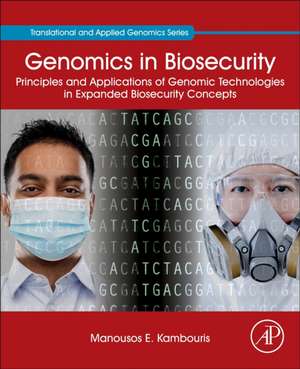Genomics in Biosecurity: Principles and Applications of Genomic Technologies in Expanded Biosecurity Concepts: Translational and Applied Genomics
Autor Manousos E. Kambourisen Limba Engleză Paperback – 25 noi 2021
Social aspects of GCBR events and genomic biosecurity, such as issues of terrorism, policy ethics, and practice, are also considered in-depth.
- Examines the use of genomics in pathogen monitoring and diagnosis, biosurveillance, and countermeasures for spontaneous and perpetrated events
- Discusses social, ethical, and policy aspects of GCBR events and the use of genomic technologies in biosecurity
- Empowers new solutions in biorestoration, biocrime, counterbioterrorism, disaster management, and humanitarian crisis response
- Features chapter contributions from a range of international specialists
Preț: 670.24 lei
Preț vechi: 877.53 lei
-24% Nou
Puncte Express: 1005
Preț estimativ în valută:
128.24€ • 134.62$ • 106.45£
128.24€ • 134.62$ • 106.45£
Carte tipărită la comandă
Livrare economică 03-17 aprilie
Preluare comenzi: 021 569.72.76
Specificații
ISBN-13: 9780323852364
ISBN-10: 032385236X
Pagini: 268
Ilustrații: 50 illustrations (30 in full color)
Dimensiuni: 191 x 235 x 22 mm
Greutate: 0.47 kg
Editura: ELSEVIER SCIENCE
Seria Translational and Applied Genomics
ISBN-10: 032385236X
Pagini: 268
Ilustrații: 50 illustrations (30 in full color)
Dimensiuni: 191 x 235 x 22 mm
Greutate: 0.47 kg
Editura: ELSEVIER SCIENCE
Seria Translational and Applied Genomics
Public țintă
Active researchers, basic and translational scientists, clinicians, postgraduates, and students in the areas of genetics, human genomics, pathology, security and biosecurity, bioengineering, and public health; infectious disease experts, public health scientists Students and active cliniciansCuprins
Part I. The Spontaneous Risk: Microbes and Bugs
1. Exploring the concepts: Biosecurity, biodefense and biovigilance
2. The concept of humanome and the microbiomic dimension
3. Global catastrophic biological risks: Nature and response
4. Surveillance policies, levels, patterns, and techniques
5. The emerging pathogens: Nature, status, and threat
6. Non-microbial biothreats: DNA, prions, and (bio)regulators/(bio)toxins
7. Public health microbiomics
Part II. The Perpetrated Biothreat: Bioterrorism, Biocrime, and Biowarfare
8. Bio-offense: Black biology
9. Bio-offense: Technical means, tactical approaches, operational orientations, and strategic concepts
Part III. Biodefense Response and Intervention
10. Biodefense response: Cognition and diagnosis
11. Bio-defence build 2.0: The muscle
12. The genomic dimension in biodefense: Therapeutics
13. The genomic dimension in biodefense: Decontamination
14. Regulation and legislation
15. Epilogue: Resilience and preparedness, the case study of the United States
1. Exploring the concepts: Biosecurity, biodefense and biovigilance
2. The concept of humanome and the microbiomic dimension
3. Global catastrophic biological risks: Nature and response
4. Surveillance policies, levels, patterns, and techniques
5. The emerging pathogens: Nature, status, and threat
6. Non-microbial biothreats: DNA, prions, and (bio)regulators/(bio)toxins
7. Public health microbiomics
Part II. The Perpetrated Biothreat: Bioterrorism, Biocrime, and Biowarfare
8. Bio-offense: Black biology
9. Bio-offense: Technical means, tactical approaches, operational orientations, and strategic concepts
Part III. Biodefense Response and Intervention
10. Biodefense response: Cognition and diagnosis
11. Bio-defence build 2.0: The muscle
12. The genomic dimension in biodefense: Therapeutics
13. The genomic dimension in biodefense: Decontamination
14. Regulation and legislation
15. Epilogue: Resilience and preparedness, the case study of the United States













